Desktop Tips
Tip #227
March 3, 2023
Delete specific form autofill entries with a simple keyboard shortcut.
Have you ever made a typo in your email address during login or wrote your name wrong while filling out a form and now the faulty entry haunts you every time you go to the page? Luckily there’s an easy way to get rid of the ghost without deleting all other autofill entries.
To delete a specific form autofill entry:
- Go to the page where the entry you want to delete is shown.
- Click on the input field to reveal the autofill suggestions.
- With a mouse or down arrow key focus on the autofill entry.
- Press Shift + Delete (Windows and Linux) or Shift + Fn + Delete (macOS) on your keyboard to delete it.
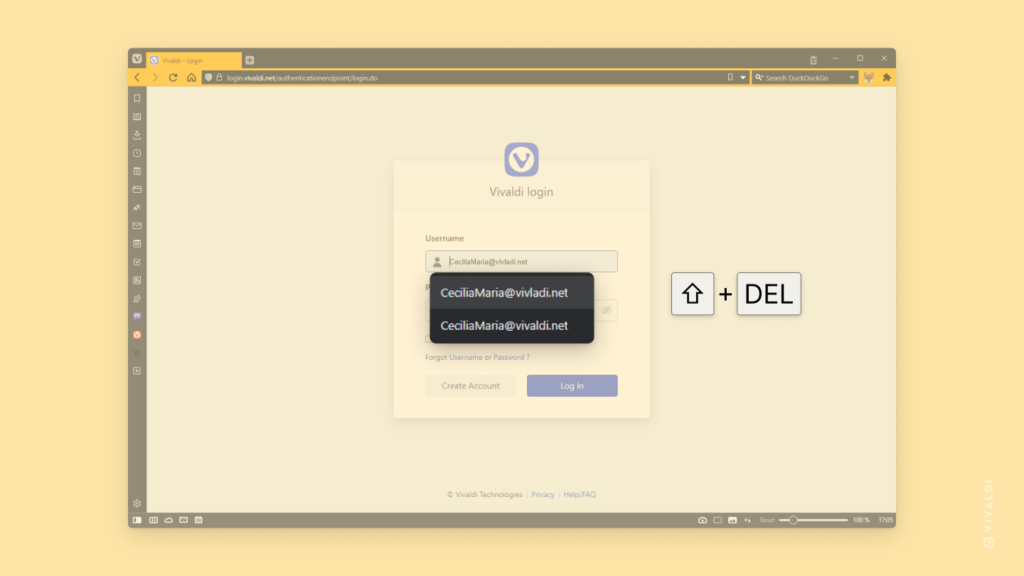
Tip #226
March 2, 2023
Reset toolbar customizations to start from fresh.
The level to which you can customize the toolbars on Vivaldi’s desktop version is unrivaled. But sometimes we can get carried away with our creativity, so it might help to take a step back and start again with the default configuration.
To reset the toolbars:
- Right-click on the toolbar you want to reset.
- From the menu, select Edit > Reset Toolbar to Default.
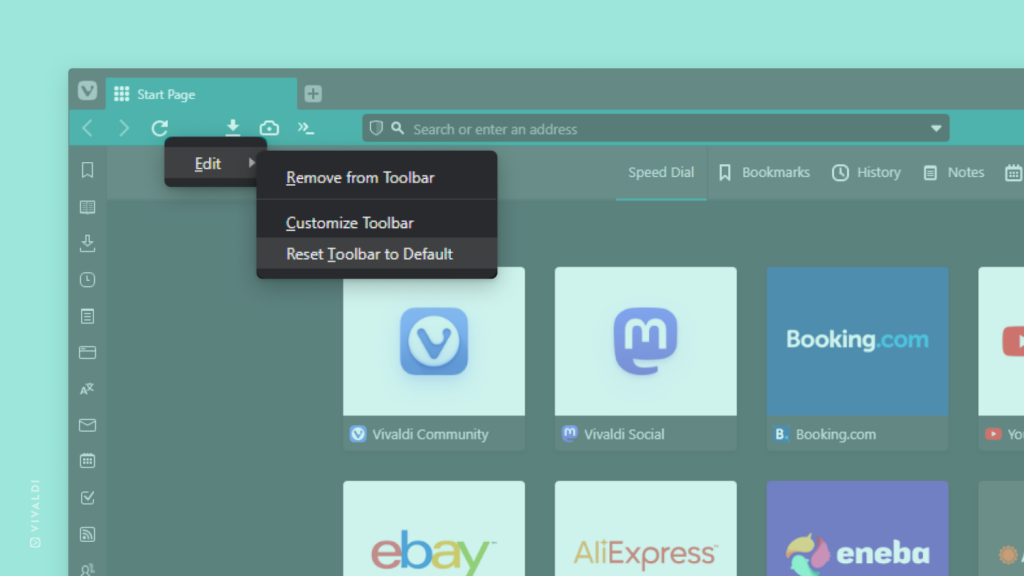
Tip #223
February 27, 2023
Use Vivaldi Feeds to listen and keep track of your favorite podcasts.
Not only can you curate your own news feed and follow your favorite YouTube channels with Vivaldi Feeds, you can also turn it into a podcast player.
To listen to podcasts in Vivaldi:
- Subscribe to the podcast with Vivaldi Feeds by going to the podcast’s website and clicking on the
 Page offers Feeds button on the right side of the Address Field.
Page offers Feeds button on the right side of the Address Field. - Using the Feeds Panel, find an episode you want to listen to.
- Double-click on the episode title in the list of feed items to open it in a new tab. That way you can keep browsing other feed posts and use Vivaldi Mail while listening to the podcast.
- Press Play on the audio player in the Linked Audio section of the feed message.
This tip has been inspired by our community member and volunteer luetage‘s post on the Vivaldi Forum.
Tip #222
February 24, 2023
Watch videos and learn about Vivaldi on our YouTube channel.
Vivaldi news and tutorials, chats with partners, live streams with the team, trendy Shorts. All this and more can be found on Vivaldi’s YouTube channel.
Visit https://www.youtube.com/@VivaldiBrowser for hours of entertainment.
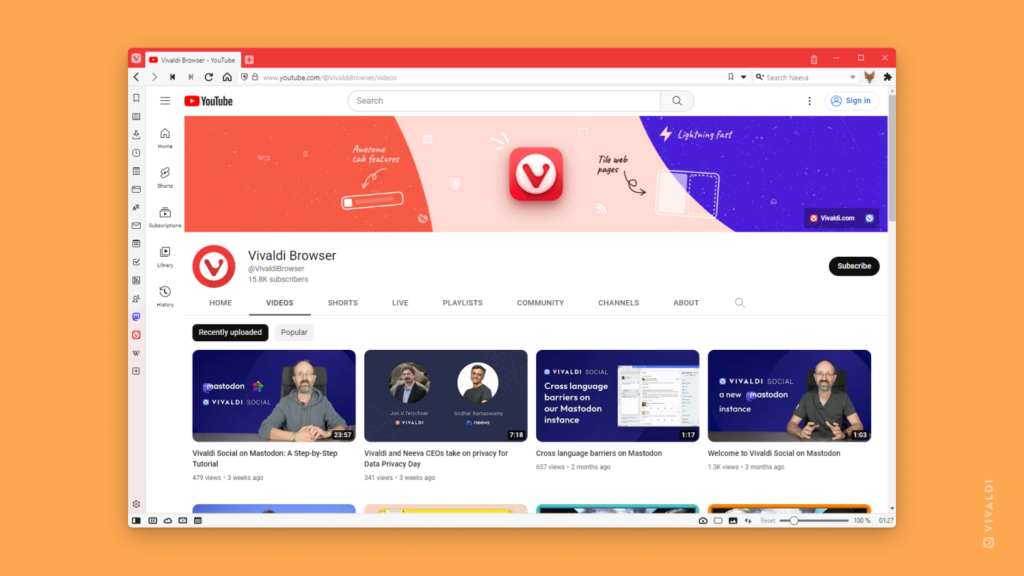
Tip #220
February 22, 2023
Select what to display in the Address Field drop-down menu.
Whenever you type a search keyword or a URL in the Address Field, you’ll get suggestions based on what you type. What is displayed there is up for you to decide.
Go to Settings > Address Bar > Address Filed Drop-Down Menu to review and update your setup.
You can include the following in the drop-down menu:
To include Search Suggestions, go to Settings > Search > Allow Search Suggestions.
If you don’t want to see anything while you type, you can disable the drop-down menu altogether.
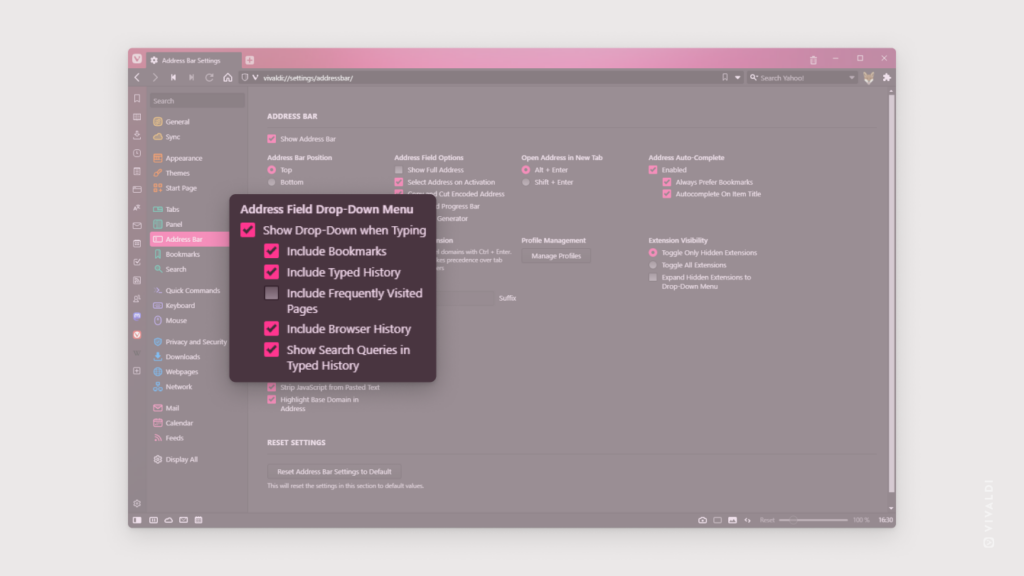
Tip #219
February 21, 2023
Create Filters in Vivaldi Mail to automatically organize incoming messages.
Having to go through each message and manually assign relevant flags and labels to them, or mark annoying messages as spam can be cumbersome. To speed up the process, set up Filters in Vivaldi Mail that do it for you.
To create Filters in Vivaldi Mail:
- Go to Settings > Mail > Mail Filters and Actions.
- Click on
 Add Mail Filter.
Add Mail Filter. - Give the filter a name
- Define the criteria for filtering.
- Click Add to Search.
- Click Add Action and decide what should happen to the messages that match the filter criteria.
- Click Add Mail Filter.
If you use Vivaldi Webmail, you can create additional filters on the server by going to Filter settings in the web interface. See Tip #75 for more info.
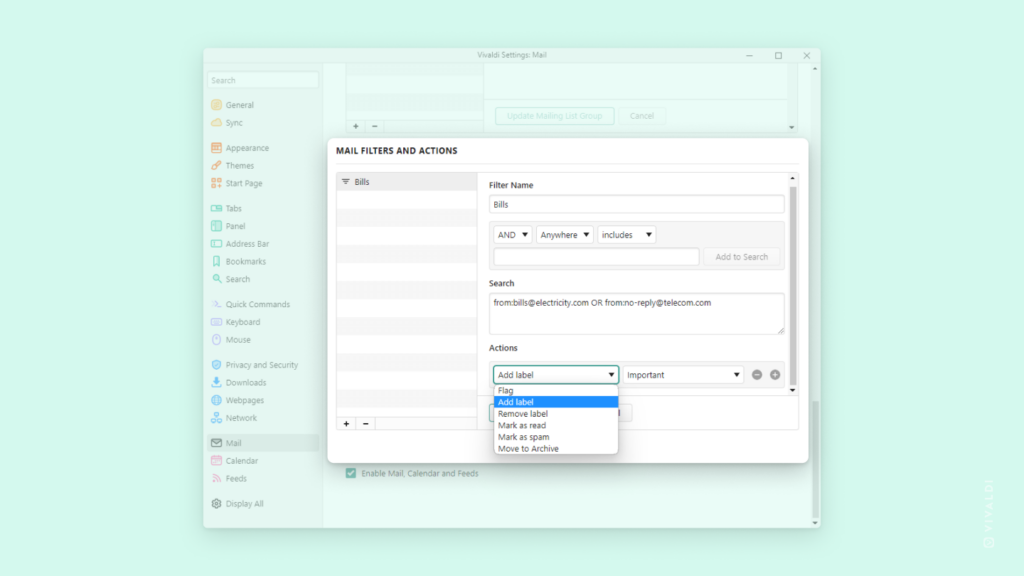
Tip #217
February 17, 2023
Block videos from automatically playing on web pages.
Do you want to have control over when a video starts playing on a web page you’re visiting? If the answer is yes then you’re in luck, because Vivaldi gives you the power to control it.
- Head over to Settings > Privacy and Security > Default Permissions.
- For Autoplay, instead of the default Allow, select Block.
Next time you load a web page where videos usually start playing immediately, you’ll need click Play when you’re ready to watch the video.
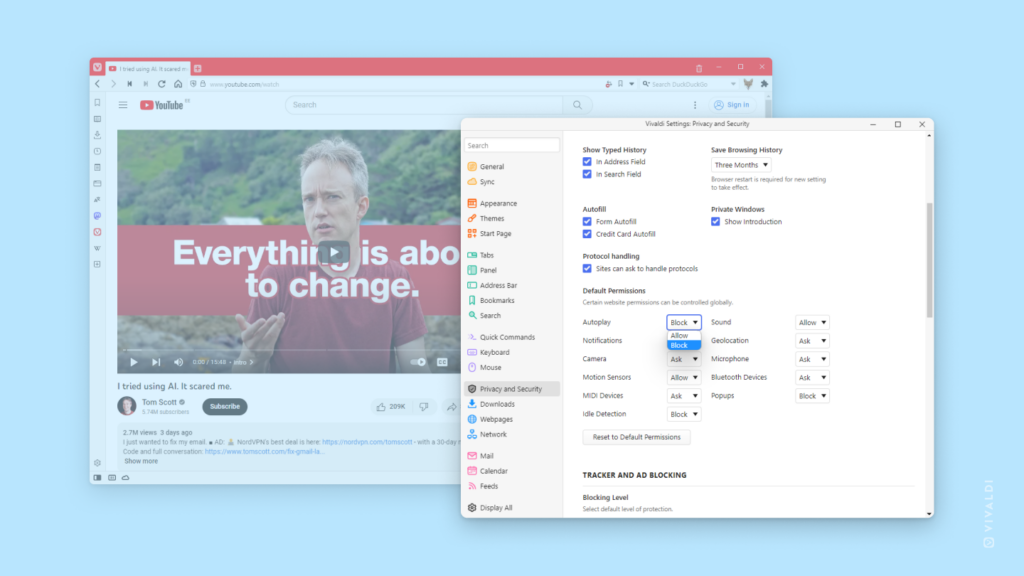
Tip #216
February 16, 2023
Move tabs from one window to another using the Window Panel.
Have you opened multiple windows with numerous tabs in each and now things look a bit too chaotic. The best place to organize your Tabs across Windows is the Window Panel.
To move tabs from one window to another:
- Open the Window Panel.
- Expand the folders listing your tabs in each window.
- Click and hold down the mouse button on a tab you want to move.
- Drag the tab to another window.
Using drag and drop it’s also easy to reorder tabs within the same window.
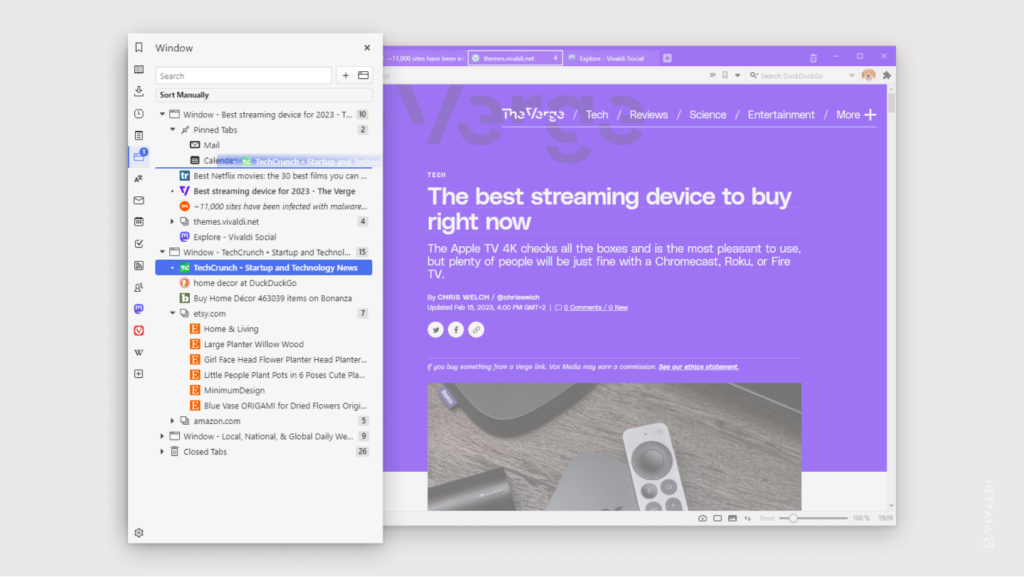
Tip #215
February 15, 2023
See the outlines of all web page’s CSS elements with CSS Debugger Page Action.
Are you using Vivaldi to work on your own website or just want to investigate how a page has been built? Then Vivaldi’s CSS Debugger Page Action will help you out. When enabled, you’ll see the outlines of each CSS element on the page. No extensions or additional tools needed.
Use one of the following options to enable the CSS Debugger:
- Click on the
 Page Actions button on the Status Bar and select CSS Debugger.
Page Actions button on the Status Bar and select CSS Debugger. - Type “CSS Debugger” in Quick Commands.
- Create a Keyboard Shortcut or Mouse Gesture for the command.
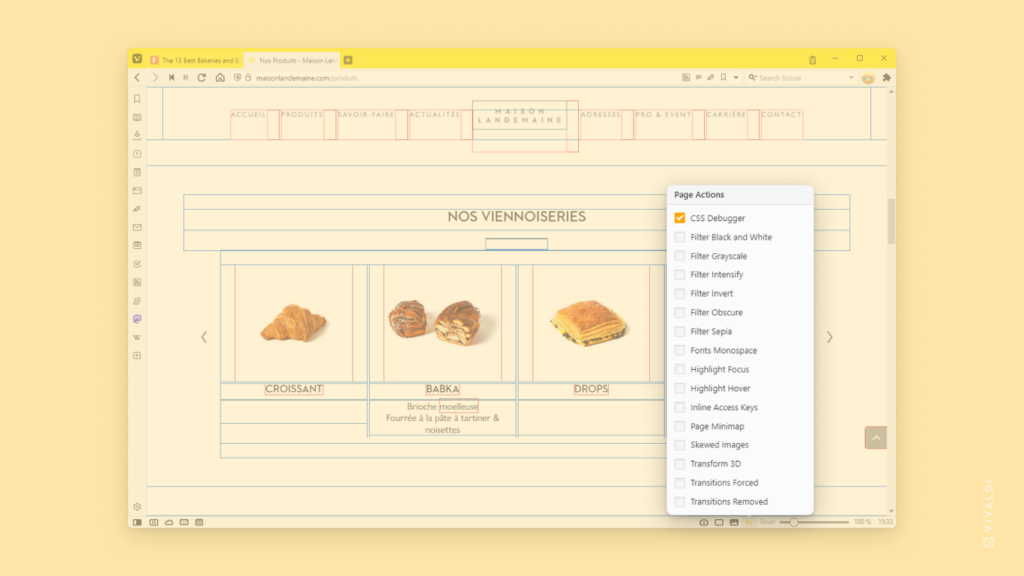
Tip #213
February 13, 2023
If someone wants to use your browser, open a Guest Profile for them.
“Could I use your computer real quick to check something?” You might have heard that question before and dreaded having to log out of your accounts or having the person see your open tabs and browsing history. There’s an easy solution for it in Vivaldi – open a Guest Profile for them. It has the browser’s default configuration and doesn’t store searches, visited sites, cookies, and temporary files.
There are a few ways you can open a Guest Window. Either:
- Click on the User Profiles button on the Address Bar and select Open Guest Window.
- Type “Guest Window” in Quick Commands.
- Create a Keyboard Shortcut or a Mouse Gesture for the command.
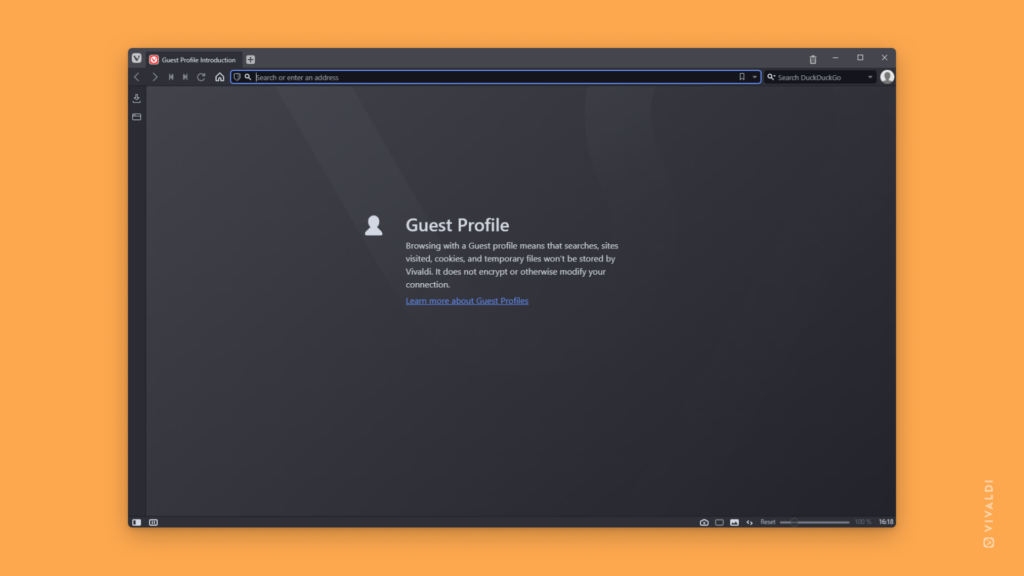
Tip #212
February 10, 2023
Reorder the menus to have your most used commands at your fingertips.
A browser should adapt to your needs not the other way around. And that’s what Vivaldi does by allowing you to customize its menus according to your preferences. For example, if you use Open Link in Background Tab more than you use Open Link in New Tab, why not switch their places and put the most used option at the top of the list?
To reorder menu commands:
- Go to Settings > Appearance > Menu > Menu Customization.
- From the dropdown menu, select which menu you want to edit.
- In the column on the left, drag and drop the menu items to rearrange their order.
The changes are applied immediately. If you want to scrap your changes and start again, just click on Restore Default Menu.
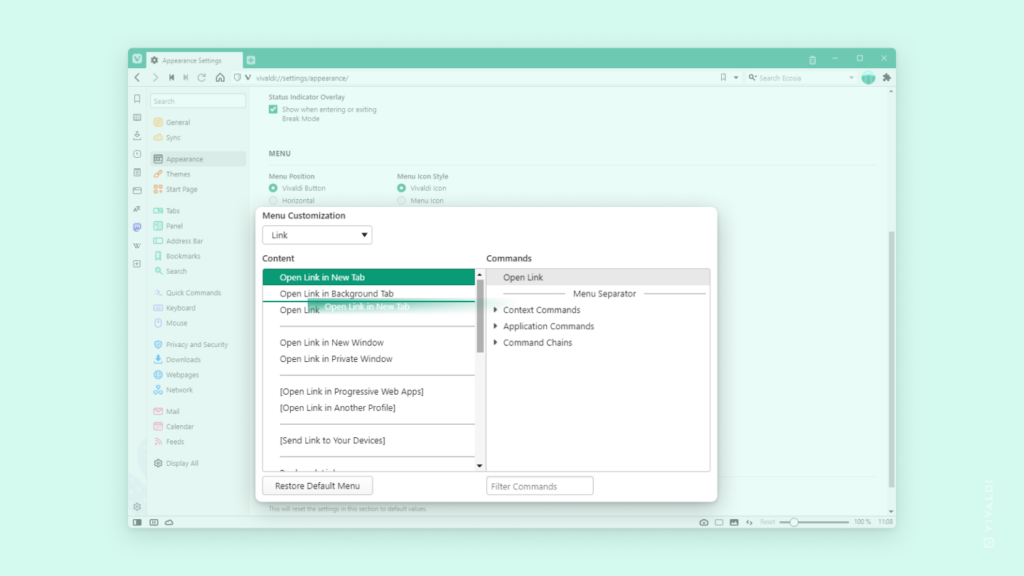
Tip #211
February 9, 2023
Use the filtering options on Vivaldi Themes to find the perfect Vivaldi browser theme for you.
Vivaldi Themes just got an update, which makes finding browser themes that match your preferences a lot easier. For example, you can look up the most popular anime and manga themes incorporating the color yellow, the newest minimalist themes in black or any other combination you can think of.
To find your perfect theme:
- Go to themes.vivaldi.net.
- On the homepage, click on “View all featured/popular/latest themes”.
- On the next page in the menu on the left side, select the criteria according to which you want to filter the themes.
- Browse through results and click on the theme for a closer look to preview and install the theme.
If you’ve made an amazing theme and want to share it with others, upload it to Vivaldi Themes by following the instructions in Tip #152.